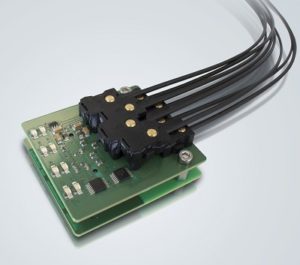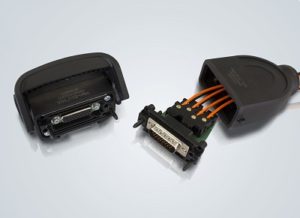Electric motors are indispensable to industrial drive technology and today’s automated production processes. At constant speeds, their control is quite simple. However, it is often necessary to regulate the motor speed, which adds a layer of complexity.

Speed regulation in the larger power classes is handled with IGBT semiconductors. These devices can switch large loads using low control power. The necessary signals for IGBT control are transmitted with polymer optical fibers (POF) because high insulation and voltage requirements must be met. The POF permit disturbance-free and galvanically isolated signal transmission. HARTING, Espelkamp, Germany, has introduced a new, miniaturized option for IGBT control at the SPS IPC Drives Fair in Nuremberg.
Typically, the connection between controller and driver board (that is, the control and motor side) has been handled by individual fibers. The electro-optical conversion of signals takes place in the circuit-board transceivers, where optical contacts establish the connection to the fibers. Each optical fiber has a single connection on both the driver and the controller board, where the transceivers are located. Thus, all transmit and receive elements on the controller board require significant space, which makes the board unnecessarily large.
A further shortcoming is the mandatory, proper positioning of various POF fibers during installation or servicing, to maintain the individual connection between each driver and controller board. This is time consuming and demands meticulous attention to detail. To guarantee the quality of the fiber end surfaces, prefabricated cables are used which can be installed on site.

Commonly used optical elements have been developed for industrial applications that handle wide temperature ranges and significant vibrations, but provide only simple strain relief for the fibers. It is also important to protect the optical interface from dirt and contamination and, when unplugged, often requires protective flaps. Cleanliness and correct installation are therefore key requirements, despite the need for numerous connections. This is expensive and non-service-friendly, in particular if a part gets damaged during operation and the entire board must be replaced.
To solve these problems, HARTING has developed a transmission principle which involves relocating the transceivers of the controller board into a pluggable module, and thus integrates the optical interface according to the principle of “electrical plugging and optical transmission.”
The design relies on HARTING’s Han-Eco 10A series, used for electrical plugging in automation applications, as the system housing. The Han housing fulfils the demanding requirements of the automation market and integrates optimal kink protection and strain relief for the fibers.
In addition, the printed circuit board in the Han housing can accommodate series resistors and supporting capacitors if required, to control the optical elements without error and prevent interference. The electrical contacts of the electrically connecting D-Sub mating face also resist wear caused by microvibrations and rougher shocks.
HARTING Technology Group
www.HARTING.com


Leave a Reply
You must be logged in to post a comment.